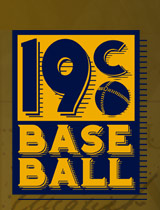ANNUAL EDITION - FOR 1864.
BEADLE'S DIME BASE-BALL PLAYER
COMPRISING THE PROCEEDINGS OF THE SEVENTH ANNUAL BASE-BALL CONVENTION
TOGETHER WITH THE RULES ADOPTED 1863. RULES FOR THE FORMATION OF CLUBS, AND INSTRUCTIONS IN THE GAME, ALSO, COMPLETE SCORES OF THE FASHION COURSE, ETC., WITH THE BASE-BALL AVERAGES FOR 1863.
EDITED BY HENRY CHADWICK
NEW YORK
BEADLE & COMPANY, PUBLISHERS
118 WILLIAM STREET.
Entered according to Act of Congress, in the year 1864.
By BEADLE AND COMPANY.
In the Clerk's Office of the District Court of the United States for the Southern District of New York.
.BEADLE'S DIME BASE-BALL PLAYER.
THIS invigorating exercise and manly pastime may now be justly termed the American Game of Ball, for though of English origin, it has been so modified and improved of late years in this country, as almost to deprive it of any of its original features beyond the mere groundwork of the game. As we propose briefly to note the progress of Base Ball from its origin, we deem it appropriate to introduce the rules for playing the English Game of Rounders, from which Base Ball is derived. We therefore quote as follows from an English work on out-door sports:
Rounders. -This game is played with a ball and bats, or sticks something of the form of a policeman's truncheon. A hole is first made, about a foot across and half a foot deep. Four other stations are marked with pegs stuck into the ground, topped with a piece of paper, so as to be readily seen. Sides are then chosen, one of which goes in. There may be five or more players on each side. Suppose that there are five. One player, on the side that is out, stands in the middle of the five-sided space, and pitches the ball toward the hole. He is called the feeder. The batsman hits it off, if he can; in which case he drops the stick, and runs to the nearest station, thence to the third, and all round if the hit has been a far one. The other side are scouting, and trying to put him out, either by hitting the batsman as he is running, or by sending the ball into the hole, which is called "grounding." The player at the hole may decline to strike the ball, but if he hits at it, and misses twice running, he is out. When a player makes the round of the stations back to the hole, his side counts one toward the game. When all the players are out, either by being hit or the ball being grounded, the other side get their innings. When there are only two players left, a chance is given of prolonging the innings, by one of them getting three balls from the feeder; and if he can give a hit such as to enable him to run the whole round, all his side come in again, and the counting is resumed. The feeder is generally the best player on his side, much depending on his skill and art. The scouts should seldom aim at the runners from a distance, but throw the ball up to the feeder or to some one near, who will try to hit or to ground, as seems the most advisable. A caught ball also puts the striker out.
The above is a very simple game, and one designed only for relaxation during the intervals from study in schools, and is entirely devoid of the manly features that characterize Base Ball as played in this country. Boys and even girls can play Rounders without difficulty; but Base Ball, to be played thoroughly, requires the possession of muscular strength, great agility, quickness of eye, readiness of hand, and many other faculties of mind and body that mark the man of nerve.
But it is needless further to comment on the meritorious features of our American game, suffice it to say that it is a recreation that any one may be proud to excel in, as in order to do so, he must possess the characteristics of true manhood to a considerable degree.
The history of Base Ball commences at a date anterior to the one we propose to start from; but our present purpose will be fully answered by tracing its progress from the organization of the Knickerbocker Club of New York, which started into existence in the autumn of 1845. There was a Club called the New York Club, which existed before the Knickerbocker, but we shall not be far wrong if we award to the latter club the honor of being the pioneer of the present game of Base Ball.
Before the organization of the Knickerbocker Club, the rule of play, in reference to putting a player out with the ball, was to throw it at him; but one or two severe accidents occurred from the practice of this plan, and the rules were changed to those placing men on each base, and making it requisite for a player to be touched by the ball while in the hands of an adversary. This latter rule was the first innovation on the primitive rules of the game familiar to every school-boy in the Eastern and Middle States. The following are the first regular rules of Base Ball we have any record of. They are those adopted by the Knickerbocker Club in 1845, and by which-with one or two exceptions-they played up to the period of the first convention of Base Ball players
The Rules: 1864 National Association of Base-Ball Players Continued ![]()
The Rules of the Game: A Compilation of the Rules of Baseball 1845–1900 ![]()

